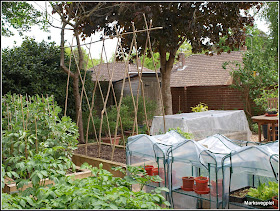Another significant milestone has been reached in my gardening year: the bean-poles have been erected. In my normal rotation plan, Purple Sprouting Broccoli is followed by Runner Beans, so the PSB plants had to finally come out. The bees will be disappointed!
When "disassembled", the four PSB plants produced a huge amount of material for the compost bin. Only the roots and a few inches of the stems have been set aside for going to the tip. After removing the PSB I refreshed the raised bed with a few handfuls of pelleted chicken manure and a generous layer of home-made compost, worked thoroughly into the soil. Runner Beans like soil that contains a lot of organic matter.
My Runner Bean plants are still quite small.
They will definitely be OK in their pots for a few more days. This will give the soil a chance to settle, and for the Blackbirds to carry out their inevitable assault on the fresh compost. Judging by the weather forecast, the soil may also get a good soaking of rain. This would be welcome, because it's currently very dry after weeks of almost no rainfall.
Then the big task - putting up the poles. This year I am using Hazel poles kindly given to me by the Countryside Services department of my local council. For me the main attraction of the Hazel is that it is locally produced and sustainable. These poles come from a place close to West Green House, about which I have written a few times. It's about 5 miles away. Also the poles are rough-textured, unlike the smooth bamboo, and this will hopefully make it easier for the beans to grip them as they climb.
The theme in my garden this year is "Quality before Quantity", so I have put up only 6 pairs of poles, with another pole along the top to aid stability. In the past I have always had 7 pairs of poles, but I think the beans will be better if they have just a little more space.
The Hazel poles are a few inches longer than my usual 8-foot bamboos, so tying them into place was a bit more difficult, even though I was able to stand on the wooden sleepers of the raised bed. I cheated a bit by using some plastic cable-ties, which are quicker and easier to use than string, cutting down on the reaching up at full stretch - something that my Fibromyalgia doesn't like at all!
So there we are then - one set of retro, rustic bean-poles all ready and waiting.
I expect to be planting out the beans in a few days, hopefully after that long-awaited rain.







Those beans are going to be so happy!
ReplyDeleteIf I may offer a bit of advice: Instead of letting my bean poles cross at the very top, I cross mine about 3/4 of the way up, within reaching distance. The bean vines will keep on climbing no matter where the poles cross. Plus I think the poles are more stable crossed before the very top.
Happy Gardening!
I can see how this might be an easier way to do it - especially if you are not 9 feet tall!
DeleteI do my bean poles with cable ties as well, but I do need for the allotment a bracing pole at one end to stop longitudinal movement I lost the whole lot a few years ago on a very windy day I was surprised at how much the foliage and beans weighed
ReplyDeleteMy garden is relatively sheltered, so I normally do OK with the configuration I have shown here - though on one famous occasion I did have to use some washing-line cord to tie my beans to a tree at one end and the house at the other! This was during one of those big storms a few years ago!
DeleteExcellent ! Isn't it a great feeling ? !
ReplyDeleteWe've been constructing a frame for sweet peas from our hazel poles. I'm not sure that we will have enough for the beans as well.
ReplyDeleteI need to get my beans out on the hillside, my plants are huge already. But the chickens are still over in that area and the plants wouldn't stand a chance from the three chooks that keep escaping, so I am using this week to harden them off before we move the chickens back to nearer the house.
ReplyDeleteJust wondering why you do not compost the roots of your PSB? Do they harbour disease? Or just take longer to break down than the leaves etc? Really enjoy your blog by the way, I have learnt a lot.
ReplyDeleteHi Cass; It's simply that the roots and lower stems of the PSB are incredibly tough and would take ages to break down in a small compost-bin like mine. I take them to the municipal tip and I'm sure their industrial composters make short work of them!
Delete